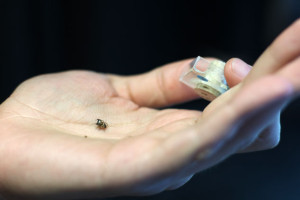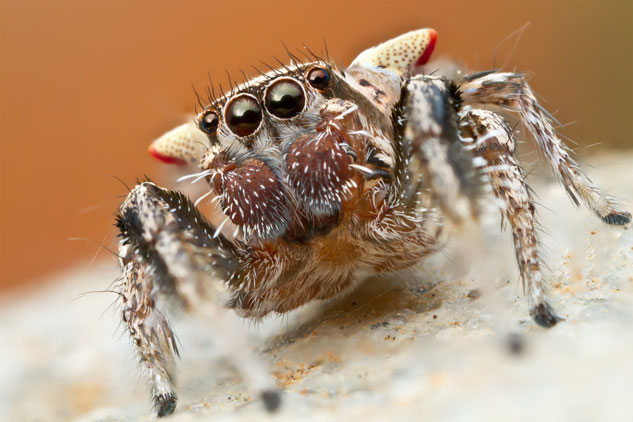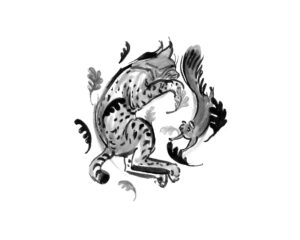Fall is spider season in the Bay Area: Giant orange orb weavers spin their masterpieces in gardens and greenbelts, and tarantulas emerge from their lairs in force.
But some of the area’s most amazing spiders are the ones you’re most likely to miss. And they probably live on your lawn.
With colorful appendages and a big pair of striking frontal eyes, the diminutive Habronattus genus of jumping spider might be one of the cutest, and most surprising, of Western arachnids.
Since they don’t use webs to hunt, they stalk their prey – like eight-legged cats. Their eyesight is better than most all spiders and insects, too – about as good as a cat’s.
But what’s most unusual about the jumping spider is the males’ sometimes-hour-plus-long courtship display, an elaborate song and dance display that’s not only unique to each species, but improvised by individuals.
Damian Elias, a UC Berkeley assistant professor who has studied the courtship rituals of Habronattus for a decade, likens the songs to a jazz composition.

“Every distinct species has its own song. And not only does it have its own song, it has a particular progression to it,” Elias said. Individuals “have their own unique ways that they can improvise, but they’re all recognizable as one particular species’ song.”
The jumping spiders’ song has a recognizable musical structure, where notes form motifs, and motifs exist within movements.
But the sound itself is different. It’s produced by creating vibrations through surfaces like a blade of grass or the ground, as opposed to air like human speech or song.
In one video produced by Elias, the male Habronattus klauserii’s song begins with a “revving” motif, followed by other combinations of thumps and taps. The spectacle is inaudible to humans without sensitive microphones.
To record his jumping spiders’ songs, Elias used a vibration-sensing laser to see how the critters move. But he needed a smooth surface to place them on.
His lab tried paper and foil, but those picked up too much background noise. As it turns out, pantyhose, which was used to build cages, provided the ideal material, both smooth and stretchy, to create trampoline-like stages where scientists can mount jumping spiders for observation.
“It was just lying around,” Elias said. “I tried a lot of different things. And pantyhose was the best.”
Using a computer and the laser, which was developed in the automobile and aeronautic industries, Elias can essentially click on an animal to see what it’s doing.
“Most things that are small use vibrations. If you’re really small, like an insect, a spider, or even small rodents, it’s much easier to move the ground than it is to move the air just because of the physics involved,” Elias said. “It’s pretty amazing that these little things are out singing for these protracted amount of times, especially since female spiders tend to be fairly dangerous audiences.”
Female spiders of many species, including jumping spiders, are known to cannibalize males after mating.
Since female spiders might only have a chance to mate a few times in their lifetime, they have to be sure to choose the right mate. That’s why males have to pull out all the stops when it comes to showing off their good genes.
For Elias, jumping spiders present a good opportunity to study what drives biodiversity. The arachnids are a relatively young class, and Habronattus as a genus is even younger.
Wherever a population of jumping spiders ends up isolated, they tend to evolve into unique forms, Elias said. “One of the reasons they’re able to do this is because they have these amazing displays,” he said. “You have this ornamentation, these songs and dances, potentially driving rapid diversification.”
There are more than 90 described species of Habronattus, and they can be found pretty much anywhere. Some jumping spiders in Elias’s lab are native to New Mexico, but many come from Point Reyes and the Central Valley.
“They’re beautiful. They’re everywhere. You can find them on campus,” Elias said. “Some of the most spectacular things are pretty common out in nature. The thing is that they’re small so people haven’t noticed them. If they were the size of birds, I think they would be as popular as birds.
“It’s one of those things,” he added. “You don’t really need to go to some far off tropical location to find things that are really spectacular and find things that are completely unknown to people, or to science.”
—
Top photo by insect photographer Colin Hutton. For more information, visit the Elias lab or check out Elias’s jumping spider YouTube video:






